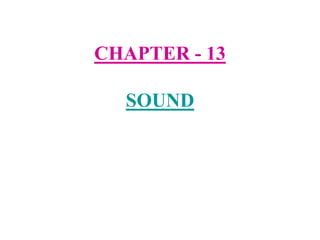
class 8 sound
- 3. 1) Sound :- Sound plays an important part in our daily lives. It helps us to communicate with each other. We hear a wide variety of sounds in our surroundings. Sound is produced by a vibrating body. Vibration is the to and fro or back and forth motion of an object. Eg :- If you strike a school bell, it vibrates and produces sound. If you pluck a stretched rubber band, it vibrates and produces sound. If you beat a drum, its stretched membrane vibrates and produces sound. If you blow a bugle, the air column vibrates and produces sound.
- 4. 2) Musical instruments and their vibrating parts :- Sl.No. Musical instrument Vibrating part producing sound 1 Veena Stretched string 2 Sitar Stretched string 3 Violin Stretched string 4 Tabala Stretched membrane 5 Mridangam Stretched membrane 6 Drum Stretched membrane 7 Shehnai Air column 8 Flute Air column 9 Mouth organ Air column
- 6. Some musical instruments produce sound when they are beaten or struck. Eg:- bell, ghatam, manjira, jaltarang etc.
- 7. 3) Sound produced by humans:- In humans sound is produced by the vioce box or larynx. It is the upper part of the wind pipe. Two vocal cords are stretched across the voice box leaving a narrow slit. When the lungs force air through the slit, it vibrates and produce sound.
- 8. 4) Sound requires a medium to propagate :- Sound travels through solids, liquids and gases. Sound does not travel in vacuum. Eg :- Sound travels through the solid thread of a can telephone. A whale listens to the reflected sound (echo) in water to locate its prey. We are able to listen to sounds because sound travels in air. (a mixture of gases)
- 10. 5) How we hear sound through our ears :- Sound enters the ear through the ear canal. It makes the eardrum to vibrate. The ear drum sends the vibrations to the inner ear. From there the signals go to the brain and then we hear the sound.
- 11. 6) Amplitude, Time period and Frequency of Vibration:- Vibration is the to and fro motion of an object. It is also called oscillatory motion. i) The maximum displacement of an oscillating body from its central position is called its amplitude. (OB or OA) ii) The motion of the pendulum from one extreme position to the other extreme position and back is called an oscillation. (A to B and back to A) iii) The time taken for one oscillation is called time period. iv) The number of oscillations per second is called frequency. The unit of frequency is hertz (Hz). A B O Motion of a simple pendulum
- 12. 7) Loudness and Pitch of sound :- i) The loudness of sound depends upon the amplitude of vibration. If the amplitude is less the sound is feeble. If the amplitude is more the sound is loud. The unit of loudness is called decibel (dB). ii) The pitch of sound depends upon the frequency of vibration. If the frequency is less the sound has low pitch. Eg :- sound of a drum, sound of an adult etc. If the frequency is more the sound has a high pitch. Eg :- sound of a whistle, sound of a baby etc.
- 13. 8) Audible and inaudible sound :- i) Audible sound is sound which we can hear. It has frequencies between 20 Hz and 20000 Hz. (Between 20 and 20000 vibrations per second). ii) Inaudible sound is sound which we cannot hear. It has frequencies less than 20Hz and more than 20000 Hz. (Less than 20 vibrations per second and more than 20000 vibrations per second) Sound whose frequencies are more than 20000 Hz is called ultrasonic sound. Some animals like dogs can hear ultrasonic sound. Bats produce ultrasonic sound.
- 14. 8) Noise and Musical sound :- i) Noise :- Unpleasant sounds are called noise. It is produced by irregular vibrations. Eg :- If all the students in a classroom speak together, a noise is produced. Sounds produced by horns of busses and trucks. ii) Musical sound :- Sound which is pleasing to the ears is called musical sound. It is produced by regular vibrations. Eg :- Sounds produced by musical instruments. Sound of a person singing a song. Nightingale
- 15. 9) Noise pollution :- The presence of excessive or unwanted sound in the environment is called noise pollution. a) Causes of noise pollution :- Noise pollution is caused by sounds of vehicles, explosions including bursting of crackers, machines, loudspeakers etc. In the home noise pollution is caused by television radio and music systems at high volume, some kitchen appliances, desert coolers, air conditioners etc. b) Harmful effects of noise pollution :- Noise pollution causes several health related problems like lack of sleep, hypertension, high blood pressure, anxiety etc. A person exposed to loud sound continuously may get temporary or permanent impairment of hearing. c) Measures to limit noise pollution :- Noise pollution can be reduced by using silencers in vehicles, industrial machines, and home appliances reducing use of vehicle horns, running TV, radio and music systems at low volumes. Planting of trees along roads and buildings also help to reduce noise pollution.